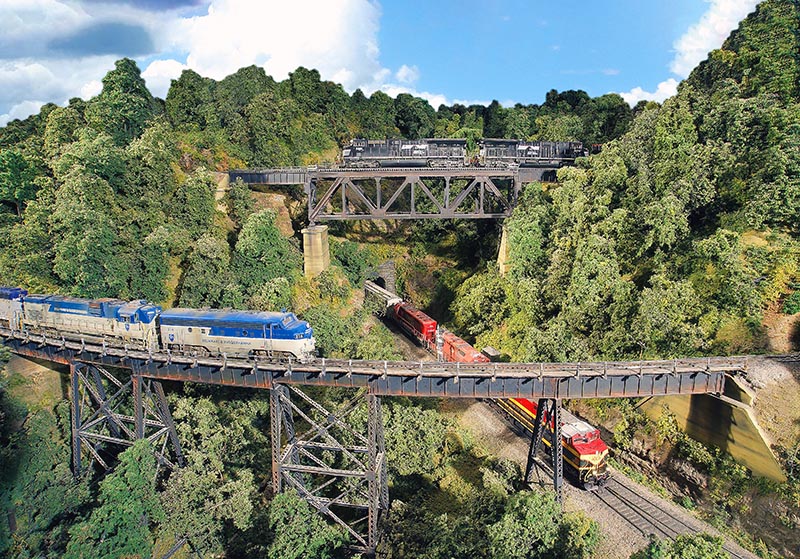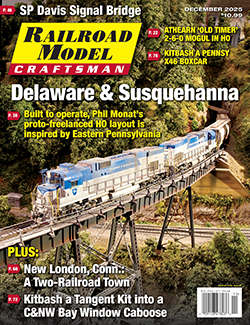 by Phil Monat/photos by the author
by Phil Monat/photos by the author
Unlike many of the beautiful layouts that I have visited, read about and operated on, mine does not share the most common of origin stories — either a love of a specific prototype railroad, an area or place where the builder grew up or a family attachment. I love all railroads but sadly could not decide which one to specifically model. I have lived and worked all over the country and they all provided scenes and scenarios that I found fascinating and held great modeling potential, but they all failed to resonate with me.
I built several layouts growing up, of course, but they were all generic and served only to refine skills and techniques. When I started building my current layout, I relied on what fascinated me most about the hobby and what I wanted out of a model railroad: a layout that featured intensive and heavy operations in the modern era. Being an active and dedicated railfan, I tend to model what I see. Transition era or steam operations set long ago are thrilling to witness, but it isn’t what I wanted to build.
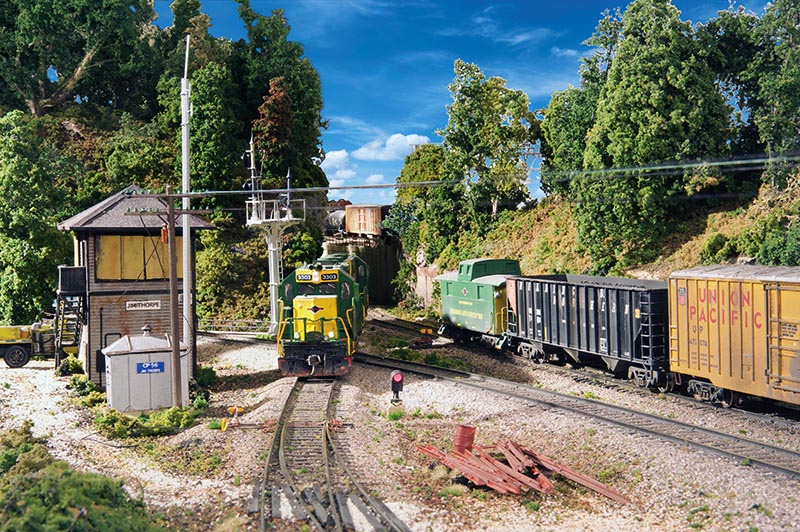
ABOVE: The Reading & Northern crew has run around their train and is preparing to work the interchange yard, as their two GP35s rattle over the diamond at Jim Thorpe. The tower is long closed and boarded up, but the signal maintainers still use the building.
I was after something that captured the modern feel of prototype operations. That meant lengthy trains with plenty of long equipment, multiple-unit consists with extensive unit train and intermodal activity, and a CTC-controlled environment. When you take those parameters and plug them into the design process, it will generate a list of requirements resembling these: 40” or greater minimum radius (to accommodate the long cars and long trains), maximum grade of 2 percent, extensive and lengthy staging tracks to support operations, and as long a main line run as can be achieved.
Reality, in the form of what space, time and money you have available, always brings us back down to earth, doesn’t it? I was fortunate enough to have a basement with a somewhat workable 1,000 square feet, unusual for my adoptive hometown of New York City. Sadly, the ceiling was mostly in the 7’ range with a few sections at 6’, so a multi-deck layout was not going to work.
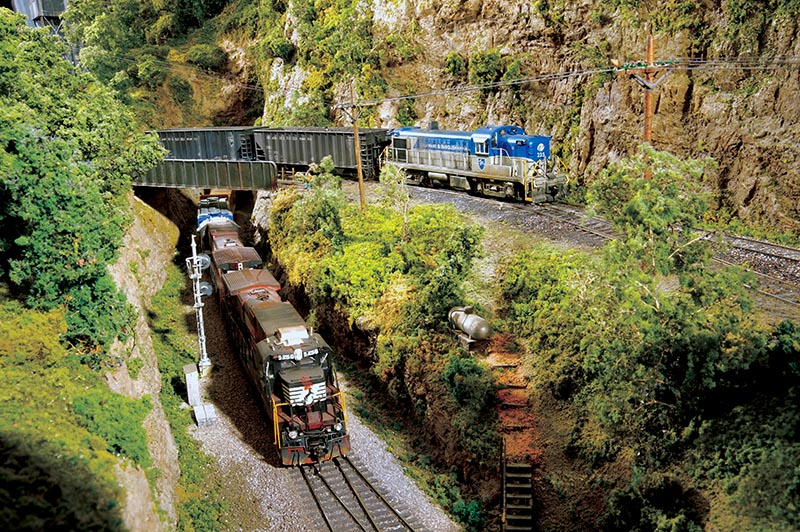
ABOVE: Train NS18G knocks down the signal entering Lehighton (CP 70) as it heads north towards Wilkes-Barre, led by two old U-boats, a C39-8 and a C40-8. Above, a D&S RS3 is building its train out of Jones Aisle mine on the Coaldale Secondary.
Instead, I designed a point-to-point scheme with a major yard on each end that at first glance resembles the old spaghetti bowl approach, but it is in fact completely linear. It does suffer from a lack of consistent directional orientation and way too much hidden track, but in exchange, it met all the intended goals – a 500-foot main line run, 40” minimum radius with a 2 percent max grade, and the ability to comfortably handle 30-to-50-car trains.
The result is essentially a multi-deck layout but with all the decks compressed into one scenic level. In a few places you can see all three levels when they cross over each other. I used extensive civil engineering to make the landforms and scenery look plausible, as it’s rare when you get extensive railroad infrastructure compressed to that degree. Lots of bridges of various types, retaining walls and rock cuts work to prevent you from seeing too much of the wrong thing while still trying to present some semblance of prototype reality. It is sort of like looking at a multi-deck railroad when you must convince your mind to ignore the deck you happen to not be on – same thing here but using civil engineering and lots of trees to achieve the same goal.
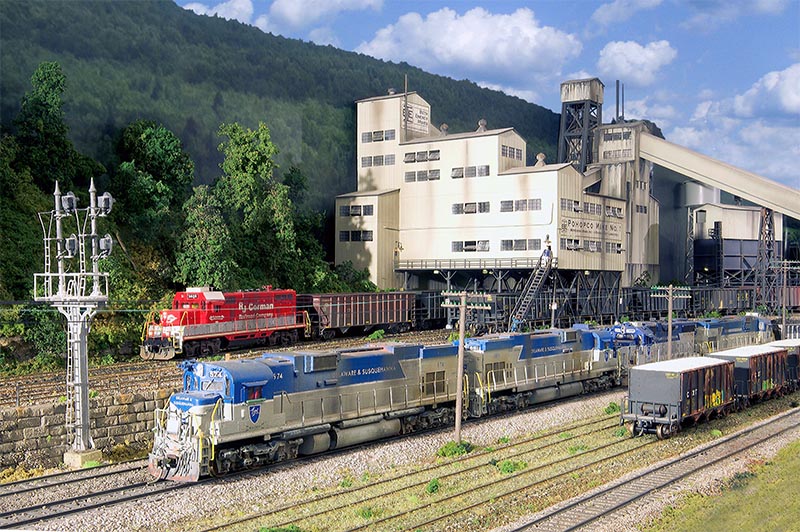
ABOVE: Jim Thorpe is dominated by Pohopco Mine No. 1, owned by Bethlehem Steel. The R.J. Corman engine, on lease to the Philadelphia, Bethlehem & New England (owned by Beth Steel), is spotting hoppers as another coal train thunders upgrade. This unit train comes onto the D&S at Allentown from NS and is headed to the Bow Mountain Power Plant in Massachusetts. It is the heaviest regular movement on the D&S and frequently draws the big Alcos, in this case two C-636s and a C-630. The mine is a kitbashed assembly of several structures.
As I worked on the layout, I was railfanning in the Allentown, Pa., area and I became aware of the Lehigh Gorge, its breathtaking scenery and especially the multiple railroads that ran thru it. Several friends also worked for Conrail (and the former Lehigh Valley and Jersey Central) in the area, and after I did some research I found my holy grail — mildly mountainous geography with steep rock cuts, tunnels, and multiple rail lines compressed into a tight valley with an abundance of traffic by at least three different railroads. In addition, Allentown on the south end features a busy yard, a huge steel complex (I am a certified hot-metal junkie), and Wilkes-Barre on the north end where I could plausibly anchor the north end of my empire.
I am most certainly a proto-freelancer, emphasis on prototype, so I went to considerable lengths to ground my railroad in reality. The “Delaware & Susquehanna” name bears homage to Delaware & Hudson, which ran on trackage rights through the area for many years. My paint scheme reinforces that illusion as does the occasional Alco. I incorporated the regional railroad Reading & Northern, as they own and operate parts of this trackage today. Building out the structures, track, and scenery to exactly match the towns along the line was not important to me, I only needed enough of a suggestion to get by the reality plausibility factor, and it allowed me to concentrate all efforts on maximizing the operating potential of the design…


